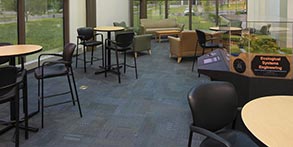- Use a predominantly neutral palette of materials with integral color that will not change over time.
- Use colors to promote soil-hiding capabilities considering the color of local soils.
- One to two accent colors are allowed to complement neutral colors using simple understated configuration.
- Avoid the use of bold or trendy colors that become undesirable over time and require updating.
Select floor materials in response to the amount of foot traffic a floor receives and to local conditions to provide the greatest long-term value.
Floor treatments (patterns and layouts) should convey the designation of the Facility Groups (Group 1, 2, 3 or 4), type of use, and type of space while considering a life cycle cost analysis. Facility Group 1 may receive higher quality treatments than Facility Groups 2 through 4, but should not convey an excessive use of resources.
Lower the initial cost of flooring in new construction while providing durability appropriate for the facility type.
Carpet must comply with requirements for performance, aesthetics, functional use and maintenance; refer to UFGS 09 68 00. Coordinate carpet selections and specifications with installation design standards.
Sustainability
Per UFC 1-200-02 passive heating and cooling strategies must be effectively incorporated into building components prior to the design of active mechanical systems. In cases where floor slabs are designed as thermal mass to supplement mechanical systems, subsequently installed floor materials and finishes must preserve the passive systems.
Evaluate proven emerging technologies, such as concrete hardening admixtures and polishing techniques for concrete slabs, and use these when available locally to provide long-wearing relatively low-cost flooring.
Under-floor air distribution systems must be evaluated based on performance within the specific climate zone.
Select materials and products with low volatile organic compounds (VOC) and with low or no pollutant emissions including concrete sealers, carpet systems, composite flooring, and adhesives. Meet or exceed Environmental Protection Agency (EPA) recommendations for recycled content. Specify products meeting or exceeding the minimum US Department of Agriculture (USDA) requirements for biobased content while meeting IFS for performance, durability and level of quality.
Resilience
Consider the effects of thermal expansion and select floor materials and installations with acceptable detailing. Ensure resistance to humidity and dust removal where applicable.
In areas subject to storm surge or flooding, follow AFCFS for prepared slabs with installations and finishes to withstand these events with minimal damage.
UFC 1-200-02 High Performance and Sustainable Building Requirements https://www.wbdg.org/ffc/dod/unified-facilities-criteria-ufc/ufc-1-200-02
UFC 3-120-10 Interior Design https://www.wbdg.org/ffc/dod/unified-facilities-criteria-ufc/ufc-3-120-10








